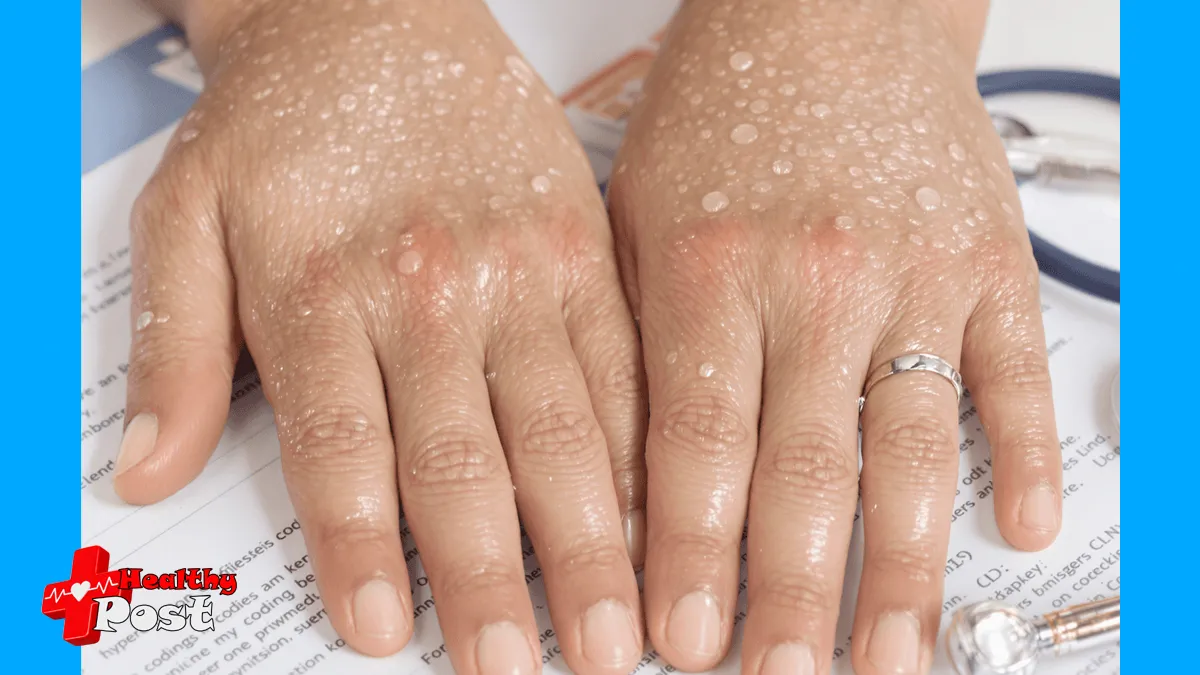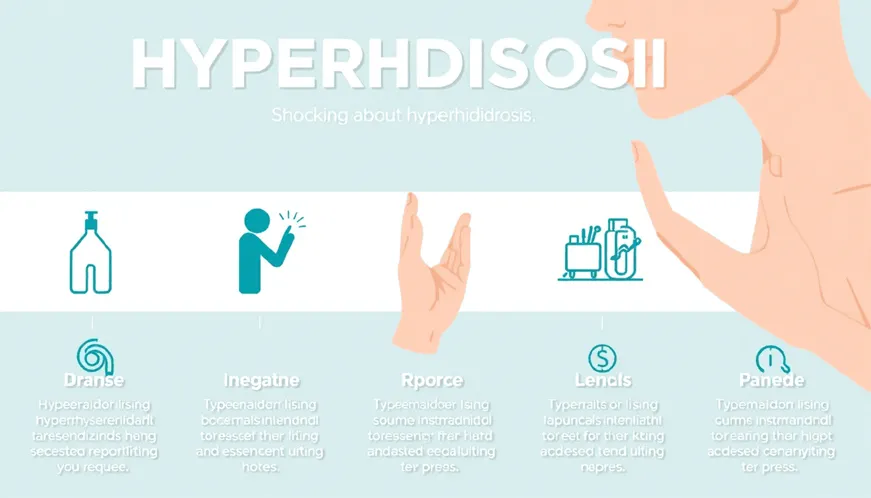
Top 7 Shocking Facts About Hyperhidrosis ICD 10 You Shouldn’t Ignore
Living with excessive sweating isn’t just uncomfortable – it’s a medical condition that affects millions worldwide. Hyperhidrosis disrupts daily activities, social interactions, and professional life in ways many people don’t realize.
The medical coding system ICD-10 plays a crucial role in managing this condition. These codes serve as a universal language between healthcare providers and insurance companies, determining treatment options and coverage for patients struggling with excessive sweating.
Did you know that hyperhidrosis can be classified into different types, each with its specific ICD-10 code? From focal hyperhidrosis affecting specific body areas to generalized hyperhidrosis impacting the entire body, proper coding makes a significant difference in treatment access.
Here’s what makes hyperhidrosis ICD-10 coding particularly interesting:
- It distinguishes between primary and secondary forms of excessive sweating
- The codes determine insurance coverage and treatment options
- Specific documentation requirements can affect treatment approval
- Different body areas affected require different coding approaches
Understanding these codes isn’t just about paperwork – it’s about getting the right treatment and support.
Understanding Hyperhidrosis and ICD-10 Coding
Hyperhidrosis disrupts lives through uncontrollable, excessive sweating that exceeds normal thermoregulatory needs. This medical condition affects specific body areas or presents as generalized sweating, creating persistent dampness regardless of temperature or physical activity.
Types of Hyperhidrosis:
- Primary Focal Hyperhidrosis: Affects specific areas like underarms, palms, face
- Secondary Focal Hyperhidrosis: Results from underlying medical conditions
- Generalized Hyperhidrosis: Impacts the entire body
The impact of excessive sweating reaches far beyond physical discomfort:
- Damaged electronics and paperwork from sweaty hands
- Stained clothing requiring frequent changes
- Reluctance to shake hands or touch objects
- Difficulty gripping tools or writing instruments
- Social withdrawal and isolation
Essential ICD-10 Codes for Diagnosis:
L74.5 – Focal Hyperhidrosis
L74.51– Primary Focal HyperhidrosisL74.52– Secondary Focal Hyperhidrosis
R61 – Generalized Hyperhidrosis
- Includes systemic sweating
- Covers night sweats
- Effective from October 1, 2024
Proper coding serves as the gateway to treatment access. Insurance providers require specific ICD-10 codes to process claims and authorize treatments. Your healthcare provider must document:
Clinical Validation Requirements:
- HDSS score measurements
- Iodine-starch test results
- Affected body areas
- Impact on daily activities
- Treatment history
Medical coding accuracy determines:
- Insurance coverage approval
- Treatment authorization
- Reimbursement rates
- Access to specialized therapies
Healthcare providers use these codes to communicate the severity and specifics of your condition to insurance companies. The difference between using L74.5 versus R61 can significantly impact your treatment options and coverage levels.
The coding system distinguishes between focal and generalized hyperhidrosis through specific identifiers. This precision helps medical professionals develop targeted treatment plans and secure appropriate insurance coverage for

Shocking Facts About Hyperhidrosis ICD 10 You Shouldn’t Ignore
Let’s dive into the hidden realities of hyperhidrosis that medical professionals and patients need to understand. These eye-opening facts reveal the true impact of this condition on daily life and emotional well-being.
1. Impact on Quality of Life
The effects of hyperhidrosis reach far beyond mere physical discomfort. Research shows that patients with hyperhidrosis experience:
Social Impact
- 88% report avoiding handshakes
- 73% feel less confident in romantic relationships
- 85% experience anxiety in social situations
- 90% modify their clothing choices daily
Professional Challenges
- 35% report missed work opportunities
- 65% face difficulties handling paper documents
- 50% struggle with electronic devices
- 82% spend extra time managing sweating during work hours
Emotional Burden
- Depression rates are 300% higher compared to the general population
- Anxiety disorders affect 47% of hyperhidrosis patients
- Social anxiety disorder is present in 54% of cases
- 38% report decreased self-esteem
The psychological impact creates a vicious cycle – stress triggers increased sweating, leading to heightened anxiety. A study published in the Journal of Dermatology reveals that hyperhidrosis patients score lower on quality of life assessments than individuals with severe acne or psoriasis.
Daily Activities Affected:
- Holding objects (phones, tools, papers)
- Writing without smudging
- Wearing certain fabrics or colors
- Participating in group activities
- Using public transportation
- Intimate relationships
The severity of these impacts often goes unrecognized by healthcare providers. Studies indicate that 49% of patients wait 10+ years before seeking medical help, primarily due to embarrassment or lack of awareness about treatment options.
Recent data from the International Hyperhidrosis Society shows that children with hyperhidrosis face unique challenges:
- 82% report difficulty taking notes in class
- 71% avoid raising their hand
- 63% experience bullying related to their condition
- 90% show decreased participation in sports activities
These statistics highlight the critical need for awareness and support for children dealing with hyperhidrosis.
2. Diagnostic Challenges and Solutions
Accurate diagnosis coding is crucial for getting treatment reimbursement for hyperhidrosis patients. However, medical professionals face specific challenges in effectively documenting and coding this condition.
Key Diagnostic Requirements:
- Detailed documentation of sweating patterns
- Specific anatomical locations affected
- Duration and severity of symptoms
- Impact on daily activities
- Family history documentation
- Ruling out secondary causes
The Hyperhidrosis Disease Severity Scale (HDSS) is an important tool for clinical validation. This standardized assessment helps healthcare providers:
- Quantify symptom severity (Scale 1-4)
- Track treatment effectiveness
- Support insurance claims
- Guide treatment decisions
Additional Clinical Validation Methods:
- Iodine-starch tests – Reveals exact sweating patterns
- Gravimetric measurements – Quantifies sweat production
- Thermoregulatory sweat testing – Maps affected areas
- Quality of life assessments – Documents functional impact
Proper ICD-10 coding requires specific documentation elements. Healthcare providers must include:
L74.51 – Primary focal hyperhidrosis L74.52 – Secondary focal hyperhidrosis R61 – Generalized hyperhidrosis
Insurance companies demand comprehensive clinical evidence. Successful reimbursement often depends on:
- Clear documentation of failed conservative treatments
- Objective measurements of sweat production
- Evidence of significant impact on daily activities
- Regular monitoring and assessment of treatment response
3. Insurance Navigation and Support Resources
Navigating insurance coverage for hyperhidrosis treatments can be challenging. Insurance providers often consider hyperhidrosis treatments as “cosmetic procedures,” making it difficult to get approval for coverage. To prove that the treatment is medically necessary, you will need specific documents and the correct ICD-10 codes.
Resources from the International Hyperhidrosis Society (IHS)
The International Hyperhidrosis Society (IHS) offers valuable resources to help patients secure insurance coverage:
- Pre-written Appeal Letters: Customizable templates addressing common insurance denial reasons
- Clinical Documentation Guidelines: Detailed checklists for healthcare providers
- Treatment Cost Guides: Comprehensive breakdowns of various treatment expenses
- Patient Advocacy Tools: Resources for self-advocacy during appeals processes
Criteria Required by Insurance Companies
Many insurance companies require specific criteria for coverage approval:
- Documented failed attempts with prescription antiperspirants
- Medical records showing persistent symptoms
- HDSS scores indicating severe impact
- Photos or clinical test results
- Letters of medical necessity from healthcare providers
Database of Insurance-Friendly Healthcare Providers
The IHS maintains a database of insurance-friendly healthcare providers experienced in hyperhidrosis documentation. These specialists understand coverage requirements and can provide appropriate clinical evidence for successful claims.
Patient Assistance Programs
Patient assistance programs through pharmaceutical companies offer additional support:
- Copay assistance cards
- Income-based discounts
- Free trial programs
- Bridge therapy options
Direct Communication with Insurance Providers
Direct communication with insurance providers through their medical review departments can expedite coverage decisions. The IHS provides scripts and talking points for these conversations, helping you navigate complex insurance terminology and requirements.
4. Treatment Access Programs and Cost Justification
The path to affordable hyperhidrosis treatment requires strategic documentation and knowledge of available cost-reduction programs. Medical providers must submit detailed clinical evidence to justify treatment necessity:
Required Documentation for Cost Approval:
- Hyperhidrosis Disease Severity Scale (HDSS) scores
- Failed previous treatment attempts
- Impact statements on daily activities
- Photos of affected areas
- Clinical test results (iodine-starch tests)
Several pharmaceutical companies offer patient assistance programs to reduce treatment costs:
Qbrexza Access Programs:
- Savings cards reducing copays to as little as $35
- Patient assistance program for uninsured individuals
- Bridge programs during insurance appeals
- Direct pharmacy discount options
Botox Treatment Support:
- Botox Savings Program covering up to $1,000 per treatment
- Income-based assistance options
- Treatment location finder services
- Insurance navigation support
The International Hyperhidrosis Society maintains a database of treatment centers offering sliding scale fees and payment plans. Many dermatology practices partner with third-party financing companies to provide interest-free payment options for approved patients.
Private insurance typically requires prior authorization for specialized treatments. A detailed cost-benefit analysis comparing long-term expenses of untreated hyperhidrosis against treatment costs can strengthen coverage appeals. This analysis should include work productivity data, clothing replacement costs, and mental health impact documentation.
5. Recognizing Related Conditions in Coding
Secondary hyperhidrosis presents unique coding challenges due to its connection with underlying medical conditions. Understanding these relationships proves crucial for accurate diagnosis and treatment planning.
Key Related Conditions:
The ICD-10 code L74.52 specifically addresses secondary focal hyperhidrosis, requiring documentation of the primary condition. Medical providers must identify and code both the excessive sweating symptoms and their root cause.
Documentation Requirements:
- Clear identification of the primary medical condition
- Detailed description of sweating patterns
- Location and severity of symptoms
- Temporal relationship between primary condition and sweating
- Treatment responses
A patient diagnosed with hyperthyroidism experiencing excessive sweating needs both endocrine disorder codes and secondary hyperhidrosis codes. This dual coding approach:
- Ensures comprehensive treatment coverage
- Supports insurance claims
- Enables proper tracking of condition progression
- Facilitates coordinated care between specialists
The International Hyperhidrosis Society reports that 32-34% of hyperhidrosis cases stem from underlying medical conditions. Accurate identification of these relationships helps healthcare providers:
- Select appropriate treatment protocols
- Predict treatment outcomes
- Monitor disease progression
- Adjust interventions based on response
Medical records should reflect regular reassessment of related conditions, as changes in primary diagnoses can significantly impact sweating patterns and treatment effectiveness.
6. Prevalence and Impact Statistics
The numbers behind hyperhidrosis paint a startling picture of its widespread impact. Research indicates that 4.8% of the U.S. population – approximately 15.3 million people – live with severe hyperhidrosis. Yet studies suggest up to half of these cases remain undiagnosed.
Age-specific statistics reveal critical patterns:
- Young Adults: 70% of cases develop before age 25
- Teens: 17.1% report excessive sweating
- Working Age: 75% of patients experience significant workplace interference
The societal impact extends far beyond individual experiences:
- $4.8 billion annual spending on antiperspirants in the U.S.
- 38% of affected individuals change clothes multiple times daily
- 35% report spending 15-60 minutes daily managing sweating
- 20% reduction in workplace productivity
Mental health statistics underscore the psychological burden:
- 47% report feeling less confident
- 35% experience anxiety in social situations
- 28% develop depression related to their condition
Gender distribution shows equal prevalence between males and females, though women are more likely to seek medical intervention. Geographic data indicates higher reported cases in urban areas, possibly due to better access to medical care and diagnosis.
The economic impact reaches beyond personal costs – workplace absenteeism and reduced productivity linked to hyperhidrosis result in an estimated $2.1 billion annual loss for U.S. businesses.
These statistics highlight hyperhidrosis as a significant public health concern requiring enhanced awareness and improved access to treatment options, including the need for more robust diagnostic resources as many cases remain undiagnosed according to recent findings from the National Center for Biotechnology Information.
7. Future Trends in Hyperhidrosis Management
The world of hyperhidrosis treatment is changing quickly with new and exciting innovations that will greatly improve patient care. Medical professionals are looking into several promising options:
1. Advanced Microwave Technology
- Next-generation miraDry systems with enhanced precision
- Reduced treatment time and improved targeting capabilities
- Lower risk of side effects through AI-guided application
2. Smart Fabric Solutions
- Moisture-wicking textiles with built-in cooling mechanisms
- Biosensor-equipped clothing for sweat pattern monitoring
- Real-time data collection for treatment optimization
3. Targeted Drug Delivery Systems
- Nano-particle based antiperspirant formulations
- Long-lasting botulinum toxin alternatives
- Patch-based delivery methods with controlled release
4. Personalized Treatment Protocols
- Genetic testing for hyperhidrosis predisposition
- AI-driven treatment selection algorithms
- Custom-tailored combination therapies
5. Minimally Invasive Procedures
- Advanced endoscopic techniques
- Nerve modulation technologies
- Outpatient procedures with reduced recovery time
6. Digital Health Integration
- Remote monitoring systems
- Virtual consultation platforms
- Mobile apps for treatment tracking
These innovations are reshaping the coding landscape, with new ICD-10 codes anticipated to accommodate emerging treatment modalities. Healthcare providers are adapting their documentation practices to include these technological advances, ensuring proper reimbursement for innovative treatments.
The integration of artificial intelligence and machine learning algorithms is expected to enhance treatment efficacy by predicting patient responses and optimizing therapeutic approaches. These technological advancements promise improved outcomes and enhanced quality of life for individuals living with hyperhidrosis.
Conclusion
The journey through these shocking facts about hyperhidrosis ICD-10 coding reveals critical insights for both healthcare providers and patients. Accurate ICD-10 coding is crucial for successful hyperhidrosis management, as it directly affects treatment access and insurance coverage.
Key takeaways from our exploration:
- Proper diagnostic coding unlocks access to essential treatments
- Clinical validation through HDSS scores strengthens insurance claims
- Patient advocacy resources exist to support treatment accessibility
- Related conditions require careful consideration in coding decisions
- New treatment technologies continue to emerge
Your path to effective hyperhidrosis management starts with understanding these coding intricacies. With this knowledge, you’re better equipped to:
- Navigate insurance requirements
- Access appropriate treatments
- Document symptoms effectively
- Communicate with healthcare providers
- Stay informed about treatment options
The impact of hyperhidrosis goes beyond excessive sweating – it affects every part of daily life. By mastering these ICD-10 coding facts, you lay a strong foundation for successful treatment outcomes. Remember: precise coding leads to proper diagnosis, which opens the door for effective treatment and improved quality of life.
Take action today – share this knowledge with your healthcare provider and advocate for your care using these essential ICD-10 insights.
FAQs (Frequently Asked Questions)
What is hyperhidrosis and how is it classified in ICD-10 coding?
Hyperhidrosis is a medical condition characterized by excessive sweating beyond what is necessary for thermoregulation. In ICD-10 coding, focal hyperhidrosis is coded as L74.5, while generalized excessive sweating may be coded under R61. Accurate classification ensures proper diagnosis and treatment reimbursement.
How does hyperhidrosis impact a patient’s quality of life and emotional well-being?
Hyperhidrosis significantly affects various aspects of life including social interactions, professional activities, and emotional health. The persistent excessive sweating can lead to embarrassment, anxiety, and reduced self-esteem, profoundly impacting overall quality of life.
Why is accurate ICD-10 coding essential for hyperhidrosis management and insurance coverage?
Accurate ICD-10 coding is crucial for validating the diagnosis of hyperhidrosis, which facilitates appropriate treatment reimbursement from insurance providers. Proper coding supports clinical validation tools like HDSS scores and helps navigate challenges in insurance approval for therapies.
What are some common challenges faced in diagnosing and coding hyperhidrosis?
Diagnostic challenges include differentiating primary hyperhidrosis from secondary causes such as hyperthyroidism. Ensuring precise ICD-10 codes that reflect these distinctions is vital for effective treatment planning and insurance navigation. Clinical validation tools help overcome these challenges.
What resources are available to support patients with hyperhidrosis in terms of treatment access and insurance navigation?
The International Hyperhidrosis Society offers valuable resources to assist patients in understanding their condition and navigating insurance complexities. Additionally, access programs exist for treatments like Qbrexza topical therapy and Botox injections, helping justify costs through detailed documentation.
What future trends are emerging in the management of hyperhidrosis?
Innovative treatments and technologies are shaping the future of hyperhidrosis management. Emerging therapies aim to improve efficacy and patient comfort, ensuring more effective control of excessive sweating while enhancing quality of life for affected individuals.

One thought on “Top 7 Shocking Facts About Hyperhidrosis ICD 10 You Shouldn’t Ignore”